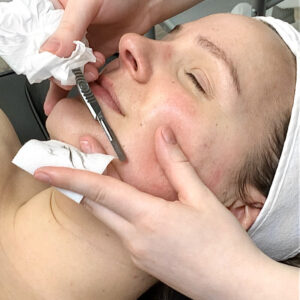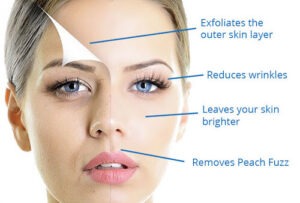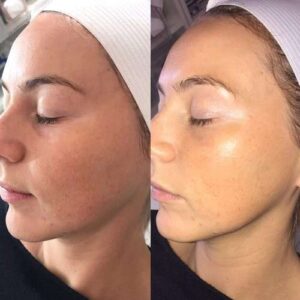DERMAPLANNING
DERMAPLANNING
Dermaplaning is a cosmetic procedure that removes dead skin cells and fine facial hair to improve the appearance of your skin. It’s also known as microplaning or blading.
Benefits
Dermaplaning can help with:
- Reducing the appearance of acne scars
- Evening skin texture
- Removing peach fuzz
- Reducing the appearance of fine lines and wrinkles
- Making skin look younger
Where it can be done
Dermaplaning can be done on the face or anywhere on the body.
- Safety
Dermaplaning is generally safe for everyone, including pregnant and lactating women.
- Hair growth
Dermaplaning only removes hair from the surface of the skin, so hair won’t grow back thicker or quicker.
What is Dermaplaning
Have you noticed your skin lacking that radiant glow? Or are you curious about achieving the smoothest skin possible without invasive treatments? Look no further than dermaplaning, a skincare technique gaining traction among beauty professionals and enthusiasts. This post will unravel the basics of dermaplaning, its history, and why it’s become such a buzzword in skincare circles.
Dermaplaning is essentially a form of physical exfoliation. Unlike chemical peels, it involves a gentle scraping of the face with a surgical scalpel to remove dead skin cells and vellus hair, often known as peach fuzz. This technique dates back to the ancient Egyptians, who used sharp-edged tools to achieve radiant skin, showcasing how timeless and effective this method can be.
In recent years, dermaplaning has been revitalized and refined, offering a modern approach to achieving flawless skin. Many are drawn to it due to its immediate results and non-invasive nature.
Lana’s Hair Loss Solutions provides high-quality hair extensions and highly skilled hair loss services. Whether you’re looking for mobile hair extensions in Bellevue, WA, micro channeling, or a hair styling specialist locally, Contact us at (360) 790-7358.
Facial Hair Removal
Although dermaplaning has rejuvenating effects on the skin, this treatment also tames facial hair. This peach fuzz preferably remains on a peach. If you are looking to have facial hair removal, consider dermaplaning. Though those fine hairs are barely visible, you’ll be happy with the removal results. Your face will glow, and your skin will feel smoother. This treatment also works on darker, more visible facial hair.
Wrinkle and Fine Line Reduction
To illustrate the benefits of skin rejuvenation, early signs of aging become minimal. Fresh skin cells help reduce the appearance of fine lines and wrinkles. Fine line reduction allows for the flawless application of cosmetics. In other words, your makeup will not cake or crack within facial wrinkles. Alternately, the lack of fine lines provides a youthful look even without cosmetics. Yes, the benefits of dermaplaning are numerous.
How Dermaplaning Works
Dermaplaning might sound intimidating, especially when you hear the words “surgical scalpel.” But fear not—this process is safe and straightforward when performed by a professional. Let’s walk through how dermaplaning works step-by-step.
First, your skincare professional will cleanse your face to remove any makeup, oil, or dirt, ensuring a clean surface for the procedure. They may then apply a gentle exfoliant to prepare your skin further, although this step varies depending on the practitioner’s technique.
Next comes the core of the process. Using a sterile surgical scalpel held at a 45-degree angle, the practitioner gently glides the blade across your skin, using small motions. This action removes layers of dead skin and fine hair, revealing the fresh, rejuvenated skin beneath. The entire session typically lasts around 30 minutes, and you’ll notice immediate results—a smoother, brighter complexion.
A key tool in dermaplaning is the scalpel, which must always be handled by a trained professional to ensure safety and effectiveness. While DIY dermaplaning kits exist, it’s crucial to approach them with caution, as improper use can lead to injury or skin irritation.
Benefits of Dermaplaning
Why should you consider adding dermaplaning to your skincare regimen? Let’s explore its myriad benefits across different skin types and concerns.
One of the most notable benefits is enhanced skin texture. By removing dead skin cells, dermaplaning helps smooth the skin’s surface, allowing skincare products to penetrate more deeply and work more effectively. This means your serums and moisturizers can provide maximum hydration and nourishment, boosting their overall efficacy.
For those who wear makeup, dermaplaning is a game-changer. Without fine hair and rough skin impeding application, makeup goes on more smoothly and evenly. You’ll notice a more flawless finish, as your foundation is less likely to cake or settle into fine lines.
Beyond aesthetics, dermaplaning also encourages cellular turnover, promoting healthier skin. It’s an excellent option for those with dry or dull complexions, as it reveals fresh skin and stimulates natural regeneration. While it benefits most skin types, those with active acne or sensitive skin should consult a professional before trying dermaplaning.
Who Can Benefit from Dermaplaning
Dermaplaning is a versatile skincare solution that can benefit a wide range of individuals. Let’s identify who stands to gain the most from this treatment.
If you struggle with dry or flaky skin, dermaplaning can be your new best friend. By removing the build-up of dead skin cells, this technique allows your moisturizer to penetrate deeper, keeping your skin hydrated and healthy.
Those seeking anti-aging solutions will also find value in dermaplaning. The procedure helps reduce the appearance of fine lines and wrinkles by promoting cellular turnover. Over time, regular dermaplaning sessions can lead to a more youthful, vibrant complexion.
For anyone dealing with uneven skin tone or hyperpigmentation, dermaplaning offers a gentle yet effective solution. It helps exfoliate the top layer of skin, gradually fading dark spots and creating a more uniform complexion. However, individuals with rosacea or eczema should consult with a dermatologist to determine if dermaplaning is suitable for their skin type.
Safety and Precautions
While dermaplaning boasts numerous benefits, safety is paramount. Ensuring a professional performs the procedure significantly reduces risks. Let’s address some safety measures and precautions you should consider.
First and foremost, only allow trained professionals to conduct dermaplaning. Their expertise ensures the procedure is executed safely, minimizing potential complications. Avoid attempting DIY dermaplaning unless you’ve thoroughly researched and practiced proper technique.
Be aware that dermaplaning may cause slight redness or irritation immediately after the session. This reaction is normal and usually subsides within a day or two. Applying a soothing, hydrating serum post-treatment can aid the healing process, keeping your skin calm and comfortable.
It’s important to avoid direct sun exposure and wear sunscreen following your dermaplaning session. Your skin will be more sensitive to UV rays, making sun protection vital to prevent damage and maintain results. Following these precautions can ensure your dermaplaning experience is safe and rewarding.
How to Prepare for a Dermaplaning Session
Preparation is key to maximizing the benefits of dermaplaning. Here’s how you can get ready for a successful treatment and ensure optimal results.
Before your session, avoid using exfoliating products—such as scrubs or acid-based skincare—for at least three days. Your skin should be free from irritation or sensitivity to prevent any adverse reactions during the procedure.
Hydration is another crucial factor. Keep your skin moisturized leading up to your appointment, as well-hydrated skin responds better to dermaplaning. Ensure you’re drinking enough water daily, and consider using a hydrating serum or moisturizer in your skincare routine.
On the day of your session, arrive with a clean face free of makeup. Your practitioner will cleanse your skin before the procedure, but a fresh start ensures no residue interferes with the treatment. After the session, follow any aftercare instructions provided by your professional to enhance your results and protect your skin.
Frequently Asked Questions about Dermaplaning
Still have questions about dermaplaning? Let’s address some common queries to put your mind at ease and help you make an informed decision.
Will dermaplaning make my facial hair grow back thicker? Rest assured, this is a common myth. Dermaplaning does not alter the structure or growth pattern of your hair. It will grow back at the same rate and texture as before the treatment.
Is dermaplaning suitable for all skin types? While dermaplaning is safe for most skin types, those with active acne, rosacea, or eczema may need to consult a dermatologist beforehand. Your skincare professional can assess your skin’s condition and advise whether dermaplaning is right for you.
How often should I schedule dermaplaning sessions? The frequency of dermaplaning varies based on individual skin needs. Typically, sessions every 4-6 weeks are recommended to maintain results and support healthy skin renewal. Your skincare professional can tailor a schedule that suits your skin goals.
Conclusion
Dermaplaning is more than just a skincare trend—it’s an effective, non-invasive way to enhance your skin’s health and appearance. By understanding its benefits, safety precautions, and preparation methods, you can make informed decisions for your skin.
Whether you’re a skincare enthusiast or a beauty professional, incorporating dermaplaning into your routine can yield glowing, refreshed skin. And remember, always consult with a certified practitioner to ensure safety and effectiveness.
Ready to transform your skincare routine? Consider booking a dermaplaning session with a trusted professional or explore DIY options if you’re well-informed. Unlock the secret to radiant skin and enjoy the confidence that comes with it. Just an FYI I also offer hair extensions!




